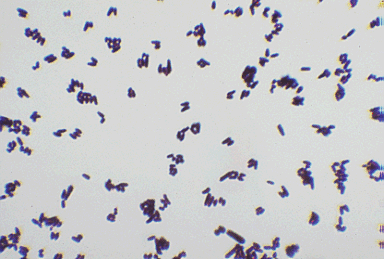CORYNEBACTERIA
CORYNEBACTERIA (IRREGULAR)
The coryneform (irregular) group of Gram-positive bacteria includes several genera of non-spore-forming
rods which are ubiquitous in nature. We will consider only two of these genera in our discussion of
clinically significant microorganisms: Actinomyces and Corynebacterium.
The first genus, Actinomyces, will be presented later when we focus on anaerobic Gram-positive
bacteria.
(under the microscope)
 The second genus, Corynebacterium, is comprised of facultatively anaerobic bacteria which are
normaly saprophitic and harmless to humans. An exception is the bacterium C. diphtheriae which
produces the toxin that causes diphtheria, a disease of the upper respiratory system in humans.
Under the microscope (best viewed using Loeffler's methylene blue dye), C. diphtheria
can be seen forming colonies which clump up or stick together. This is a characteristic associated
with many higher forms of bacteria. Although other species of Corynebacterium can inhabit the mucous
membrane, C.diphtheriae is unique in its exotoxin formation. Treatment for the disease usually consists of
administration of an antitoxin with penicillin.
The second genus, Corynebacterium, is comprised of facultatively anaerobic bacteria which are
normaly saprophitic and harmless to humans. An exception is the bacterium C. diphtheriae which
produces the toxin that causes diphtheria, a disease of the upper respiratory system in humans.
Under the microscope (best viewed using Loeffler's methylene blue dye), C. diphtheria
can be seen forming colonies which clump up or stick together. This is a characteristic associated
with many higher forms of bacteria. Although other species of Corynebacterium can inhabit the mucous
membrane, C.diphtheriae is unique in its exotoxin formation. Treatment for the disease usually consists of
administration of an antitoxin with penicillin.
LABORATORY INDICATIONS:
- Catalase +
- Nitrate +
- Glucose fermentation
- Non-motile



 Copyright © 1995 University of Texas - Houston Medical School, DPALM MEDIC, All rights reserved.
Copyright © 1995 University of Texas - Houston Medical School, DPALM MEDIC, All rights reserved.
 The second genus, Corynebacterium, is comprised of facultatively anaerobic bacteria which are
normaly saprophitic and harmless to humans. An exception is the bacterium C. diphtheriae which
produces the toxin that causes diphtheria, a disease of the upper respiratory system in humans.
Under the microscope (best viewed using Loeffler's methylene blue dye), C. diphtheria
can be seen forming colonies which clump up or stick together. This is a characteristic associated
with many higher forms of bacteria. Although other species of Corynebacterium can inhabit the mucous
membrane, C.diphtheriae is unique in its exotoxin formation. Treatment for the disease usually consists of
administration of an antitoxin with penicillin.
The second genus, Corynebacterium, is comprised of facultatively anaerobic bacteria which are
normaly saprophitic and harmless to humans. An exception is the bacterium C. diphtheriae which
produces the toxin that causes diphtheria, a disease of the upper respiratory system in humans.
Under the microscope (best viewed using Loeffler's methylene blue dye), C. diphtheria
can be seen forming colonies which clump up or stick together. This is a characteristic associated
with many higher forms of bacteria. Although other species of Corynebacterium can inhabit the mucous
membrane, C.diphtheriae is unique in its exotoxin formation. Treatment for the disease usually consists of
administration of an antitoxin with penicillin.



